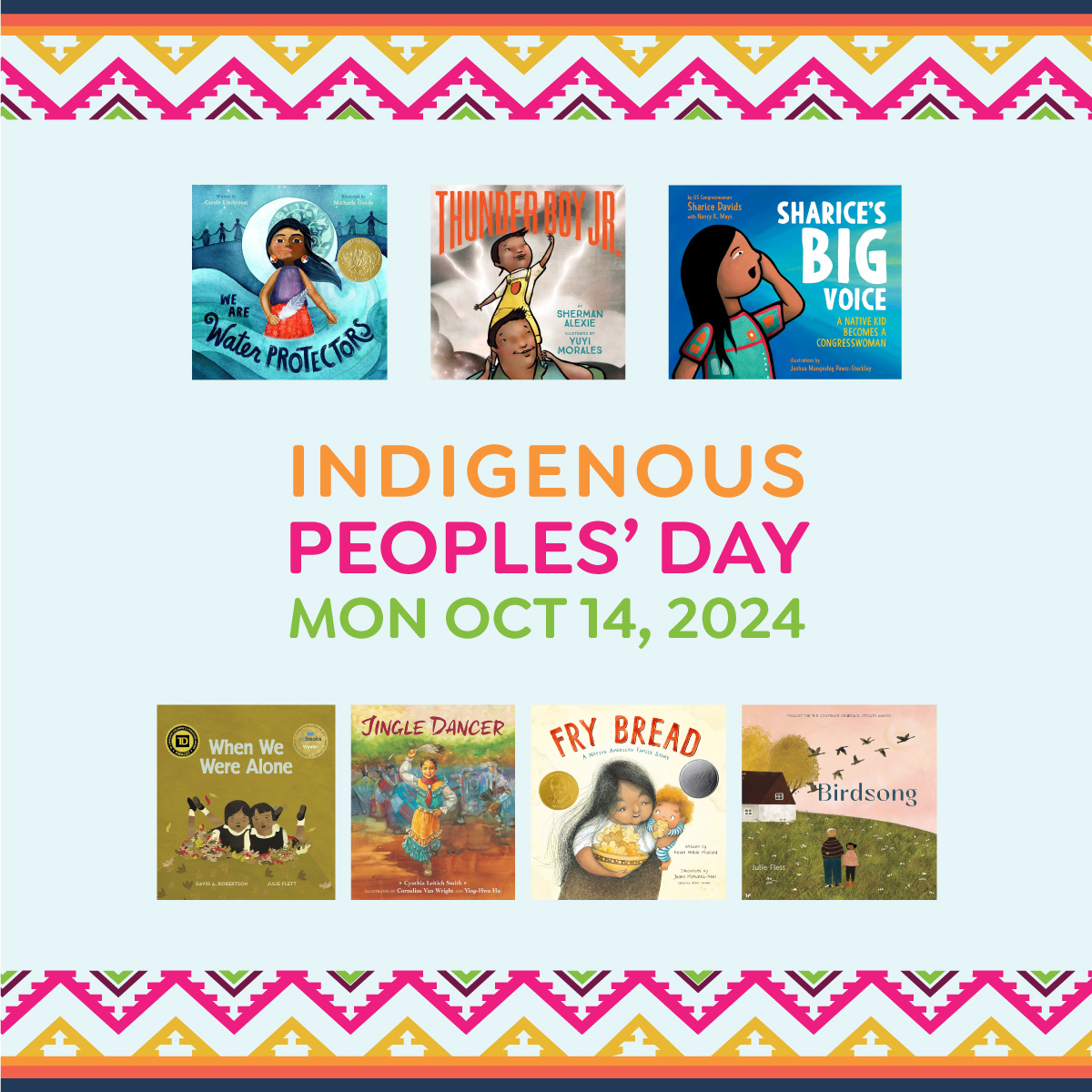Indigenous Peoples’ Day serves as a reminder to make time to honor and celebrate the rich cultures, histories, resilience, and contributions of Indigenous communities. Sharing stories about Indigenous history and experiences written by Indigenous authors can help students develop a deeper understanding and appreciation for Indigenous cultures and perspectives. These books are windows into the lives, wisdom, and heritage of Indigenous peoples, offering young readers a chance to deepen their understanding and appreciation of these rich traditions. Dive into the selected texts below and you will find meaningful stories that pay tribute to the past, acknowledge the present, and look to the future of Indigenous people from many backgrounds.
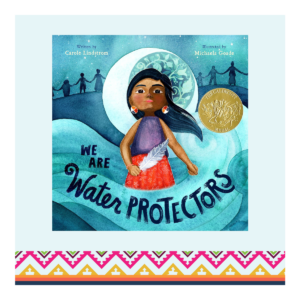 1. We Are Water Protectors by Carole Lindstrom (Anishinaabe/Metis), illustrations by Juana Martinez-Neal
1. We Are Water Protectors by Carole Lindstrom (Anishinaabe/Metis), illustrations by Juana Martinez-Neal
This beautifully illustrated book follows the story of a young girl who stands up to protect the water from a black snake that threatens to harm the Earth. We Are Water Protectors introduces students to the importance of environmental stewardship, a key value in many Indigenous cultures. It encourages a sense of responsibility towards protecting nature and respecting Indigenous perspectives on environmental issues.
Carole Lindstrom is Anishinaabe/Metis and an enrolled member of the Turtle Mountain Band of Ojibwe. Her writing reflects her deep commitment to Indigenous sovereignty, environmental protection, and cultural continuity. Michaela Goade, a member of the Tlingit and Haida Tribes of Alaska, illustrated We Are Water Protectors with luminous watercolor art inspired by her homeland’s natural world and Indigenous stewardship traditions.
Use in the Classroom: Discuss the importance of water conservation and environmental activism. Have students create posters or write about causes they value and how they can have a positive impact in their communities.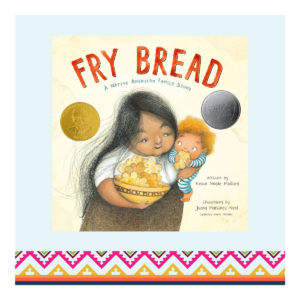
2. Fry Bread: A Native American Family Story by Kevin Noble Maillard (Seminole Nation), illustrations by Juana Martinez-Neal
If you’ve tasted it, you know. This book celebrates the tradition of fry bread, exploring its significance across different Native American cultures. The story is woven with themes of family, tradition, and history. Fry Bread serves as an entry point into understanding how traditions and other aspects of culture, especially connections with food, shape identities and impact the community.
Kevin Noble Maillard is a member of the Seminole Nation, Mekusukey Band, and his work often explores Native identity, food, and cultural continuity. The illustrator, Juana Martinez-Neal, brings warmth and depth to Fry Bread through her sensitive portrayal of family and tradition. Together, they celebrate how food connects Native families across generations.
Use in the Classroom: If you’re able, use the book’s recipe to make fry bread together and explore the history and stories behind it. After reading, discuss the significance of cultural traditions and have students share their family traditions. You might want to open up an invitation to share, or at least share about, food special to students’ families and community.
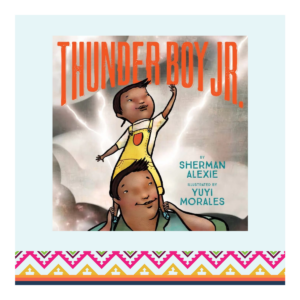 3. Thunder Boy Jr. by Sherman Alexie (Spokane/Coeur d’Alene), illustrated by Yuyi Morales
3. Thunder Boy Jr. by Sherman Alexie (Spokane/Coeur d’Alene), illustrated by Yuyi Morales
This story follows Thunder Boy Jr., a young boy who wants a name of his own, one that reflects something he has done rather than being named after his father. It’s a tale about identity and the desire for individuality. Readers respond to the universal themes of self-expression and belonging and reflect on the importance of names and identity in Indigenous cultures. For some students, this may be the first time they reflect on their own identities and the meanings behind their names.
Sherman Alexie, a Spokane and Coeur d’Alene author, is known for his vivid storytelling and humor that highlight the complexities of Native identity and contemporary Indigenous life. Yuyi Morales, who illustrated Thunder Boy Jr., brings her signature expressive style to the story, reflecting her own experience of cultural heritage and belonging.
Use in the Classroom: Encourage students to explore the meanings of their names or to create new names that reflect something important to them. This can lead to discussions about identity, heritage, and the significance of names across many different cultures.
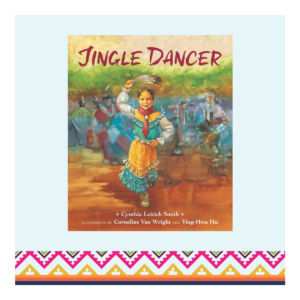 4. Jingle Dancer by Cynthia Leitich Smith (Muscogee Creek), illustrated by Cornelius Van Wright and Ying-Hwa Hu
4. Jingle Dancer by Cynthia Leitich Smith (Muscogee Creek), illustrated by Cornelius Van Wright and Ying-Hwa Hu
Jenna, a young Muscogee girl, wants to dance at the next powwow but needs enough jingles for her dress. The story follows her journey as she gathers jingles from women in her community, reflecting themes of tradition and community support. Jingle Dancer provides insight into the significance of powwows and the role of community and tradition in Indigenous cultures. It teaches students about the importance of cultural practices and intergenerational support.
Cynthia Leitich Smith is a citizen of the Muscogee Creek Nation and one of the most influential voices in Native children’s literature. Her writing often centers on community, identity, and cultural pride, as seen in Jingle Dancer, which celebrates intergenerational bonds and the power of tradition.
Use in the Classroom: Use this book to discuss cultural traditions and the role of the community in maintaining these traditions. Students can create their own “jingles” by writing or drawing something they contribute to their communities or families.
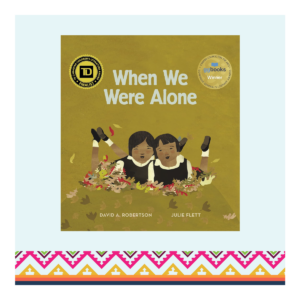 5. When We Were Alone by David A. Robertson (Swampy Cree), illustrated by Julie Flett
5. When We Were Alone by David A. Robertson (Swampy Cree), illustrated by Julie Flett
When We Were Alone tells the story of a young girl who asks her grandmother about her experiences as a child in a residential school. Through these conversations, the grandmother shares how she maintained her identity despite efforts to erase her culture. For many students, this may be their introduction to the tragic reality of residential schools. The deeply personal story of resilience and cultural identity fosters empathy and understanding regarding the lasting impacts of historical injustices on Indigenous communities.
David A. Robertson is a Swampy Cree author from Winnipeg whose stories often focus on truth, reconciliation, and cultural survival. When We Were Alone draws from his family’s experiences and seeks to help young readers understand the legacy of residential schools and the resilience of Indigenous peoples.
Use in the Classroom: This book can be a starting point for discussions about history, cultural preservation, and the ongoing impacts of colonialism as well as the importance of preserving cultural identity and resilience in the face of adversity. Additional reading and/or viewing can help students understand how difficult it is to hold onto your identity and sense of self when authority figures and the dominant culture do not respect your community.
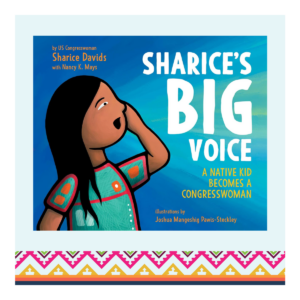 6. Sharice’s Big Voice: A Native Kid Becomes a Congresswoman by Sharice Davids (Ho-Chunk Nation) with Nancy K. Mays, illustrated by Joshua Mangeshig Pawis-Steckley
6. Sharice’s Big Voice: A Native Kid Becomes a Congresswoman by Sharice Davids (Ho-Chunk Nation) with Nancy K. Mays, illustrated by Joshua Mangeshig Pawis-Steckley
Perfectly timed for an election season, this inspiring picture book tells the true story of Sharice Davids, one of the first Native American women elected to Congress. It follows her journey from a young girl to a trailblazing leader. Highlighting themes of perseverance, leadership, and representation Sharice’s Big Voice inspires students to dream big and understand the importance of diverse voices in leadership roles.
Sharice Davids is an enrolled member of the Ho-Chunk Nation and one of the first Native American women elected to the U.S. Congress. Her picture book, Sharice’s Big Voice, shares her journey and encourages young readers to embrace their identity and speak up for their communities. Illustrator Nancy K. Mays helps convey the book’s energy and optimism through vibrant, accessible art.
Use in the Classroom: Facilitate a discussion around the importance of representation in government and leadership and the impact of certain groups being more or less represented in any level of government. Encourage students to envision how they can be leaders in their communities now and in the future and have them share what issues they are passionate about.
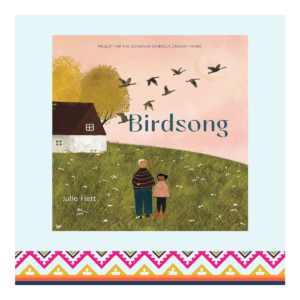 7. Birdsong by Julie Flett (Cree-Metis)
7. Birdsong by Julie Flett (Cree-Metis)
Birdsong is a gentle, lyrical story about a young girl who moves to a new home and forms a close bond with an elderly neighbor. It’s a celebration of intergenerational friendship and the changing seasons of life. Flett emphasizes the importance of community, connection, and the relationships between different generations. Children see and can reflect on the stages and cycles of life and the timeless importance of art and creativity in expressing feelings.
Julie Flett is a Cree-Métis author, illustrator, and artist known for her gentle, minimalist storytelling and earthy, textured illustrations. Her work, including Birdsong, celebrates relationships between people and the natural world, the seasons of life, and the importance of intergenerational connection and creativity.
Use in the Classroom: Encourage students to create artwork or write poems inspired by the seasons or by special relationships in their lives. Discuss the importance of connecting with elders and sharing stories across generations. Engage family and/or community members in creating, sharing, and talking about their art or the art of the community.
Incorporating these beautiful stories from Indigenous cultures into your classroom is part of creating a more inclusive, empathetic, and culturally aware learning environment this month and every month. For additional resources, we recommend you check out these Indigenous People’s Month teaching resources from the National Education Association.
You can continue honoring the contributions of all people by bringing Youth Empowered Stewardship (YES) to your school. YES is an innovative, experiential process that builds authentic partnerships between students and adults to create vibrant, sustainable communities. Through music, movement, and visual arts, facilitators foster multi-generational collaboration to address complex challenges and drive continuous, asset-based improvement. YES echoes the spirit of these books by uplifting youth voices and building equity through creativity, collaboration, and connection.


